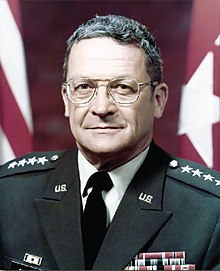John R. Guthrie
| John Reiley Guthrie | |
|---|---|

General John Reiley Guthrie
|
|
| Born |
December 20, 1921 Phillipsburg, New Jersey |
| Died | May 25, 2009 (aged 87) Walter Reed Army Medical Center |
| Allegiance |
|
| Service/branch |
|
| Years of service | 1942–1981 |
| Rank |
|
| Commands held | U.S. Army Materiel Readiness and Development Command IX Corps |
| Battles/wars |
World War II Korean War Cold War |
| Awards |
Distinguished Service Medal Legion of Merit Bronze Star Medal |
| Other work | Trustee, Princeton University Director, Landpower Education Program |
John Reiley Guthrie (December 20, 1921 – May 25, 2009) was a United States Army four-star general who served as Commanding General, U.S. Army Development and Research Command (CG DARCOM), from 1977 to 1981. In the 1980s, DARCOM was renamed United States Army Materiel Command.
Guthrie was born in Phillipsburg, New Jersey, on December 20, 1921. He graduated from Princeton University with a B.A. degree in 1942. An honor graduate of the Princeton ROTC, he was commissioned a 2nd lieutenant, Field Artillery Reserve, and immediately ordered to active duty. He was integrated into the Regular Army in July 1946, while on duty with the War Department General Staff. In October 1946, he was assigned to London, England as Assistant to the Military Attaché, where he served for three years.
In November 1949, he returned to the U.S. and was assigned to the 39th Field Artillery Battalion, 3rd Infantry Division, Fort Benning, Georgia. He served as Battery Commander and S-3 of the 39th at Fort Benning, Japan and Korea, until June 1951 when he was assigned as S-3, 3rd Infantry Division Artillery. During this period, he participated in operations against guerrillas in the Wonsan area, the evacuation from Hŭngnam, the reoccupation of Seoul and the spring Chinese offensive and United Nations counteroffensive.
Upon his return to the United States, he commanded the 602nd Field Artillery Battalion and Fort Sill from February 1952 to May 1953. He was then assigned to the Staff and Faculty at the Artillery and Guided Missile School as a member of the Combat Developments Department. In March 1956, he was transferred to the Office of the Chief of Research and Development, HQDA, for duty with the Surface-to-Surface Missiles Division and later with the Missiles and Space Division. He was the Army Staff project officer for the launching of the United States' first artificial earth satellite, Explorer 1. In July 1958, he was assigned as the Military Assistant to the Secretary of the Army and was appointed Assistant Executive to the Secretary of the Army on August 1, 1959.
...
Wikipedia
